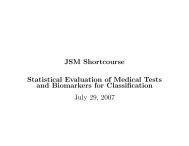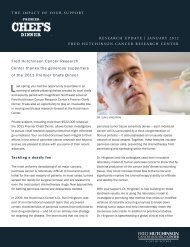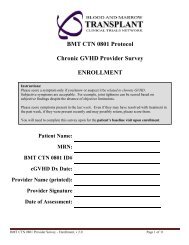Summer Undergraduate Research Program - Fred Hutchinson ...
Summer Undergraduate Research Program - Fred Hutchinson ...
Summer Undergraduate Research Program - Fred Hutchinson ...
Create successful ePaper yourself
Turn your PDF publications into a flip-book with our unique Google optimized e-Paper software.
Human papillomavirus infections in mid-adult women<br />
Taylor Lasof1,2 , Joseph Carter1 , Jane Fu3 , Rachel Winer3 , Denise Galloway1 1<strong>Fred</strong> <strong>Hutchinson</strong> Cancer <strong>Research</strong> Center, Seattle, WA<br />
2University of San Diego, San Diego, CA<br />
3University of Washington, Seattle, WA<br />
Conclusions<br />
Results<br />
Introduction<br />
Characteristics of the antibody response in mid-adult women to HPVs:<br />
• Infection increased in women with more partners<br />
2012 Best Poster Award<br />
• Antibodies for each HPV type were detected at a high frequency<br />
• Of the HPV types associated with Anogenital cancers, 16 and 59<br />
were the most prevalent<br />
• 22% of the women were antibody positive for at least one high-risk<br />
HPV type<br />
• 36% of the women had 3 or more of the high-risk HPV types tested<br />
Figure 3. Phylogenetic tree of human papillomavirus. Different<br />
colors depict different species of HPV types.<br />
Future Directions<br />
Table 1. Serostatus and demographics of the population. There<br />
were no significant differences between seropositive and<br />
seronegative women. (N=409).<br />
This study examines the natural history of genital human papillomavirus (HPV)<br />
infections and the epidemiology of HPV infections among women aged 30 to<br />
50 years. HPV is a sexually transmitted infection and an important cause of<br />
cervical cancer, which is the third most common cause of cancer among<br />
women worldwide. These viruses also cause a significant proportion of<br />
oropharyngeal cancers. Gardasil and Cervarix are vaccines that protect against<br />
infection in females and males 9-26 years of age by initiating an antibody<br />
response before they have been exposed to HPVs. These vaccines protect<br />
against the most prevalent HPV types: 16, 18, 6 and 11. HPV 16 and HPV 18<br />
cause 75% of cervical cancer cases, whereas HPV 6 and 11 cause 90% of<br />
genital wart cases.<br />
HPV has been researched thoroughly in young adults, however, less is known<br />
about the virus in adult women. The goal of this research is to better<br />
understand HPV infections in women 30-50 years of age and the risk factors<br />
associated with each type of infection so that well-informed public health<br />
decisions can be made regarding vaccination, treatment, and guidance for<br />
HPV patients. The work presented here examined the antibody response to<br />
17 HPV types, 14 of which are associated with cervical cancer. Antibodies<br />
detected in 93% of these women were due to natural infection as they had<br />
not been vaccinated.<br />
110<br />
Using this serology data along with HPV DNA detection among these<br />
women:<br />
• Determine if incident DNA detection is due to reactivated or a new<br />
infection<br />
Objectives<br />
Characterize the antibody response in mid-adult women to HPVs<br />
• Study the risk factors associated with new and reactivated infections<br />
• Determine the prevalence of types associated with anogenital<br />
cancers among these women<br />
• Determine the number of types to which women have antibodies<br />
• Determine if antibodies to these types are associated with the<br />
number of lifetime sex partners<br />
References<br />
• Waterboer, Tim. “Multiplex Human Papillomavirus Serology Based<br />
on In Situ-Purified Gluathione S-Transferase Fusion<br />
Proteins.”Clinical Chemistry. 1845-1853. (2005).<br />
Figure 4. Percent of individuals seropositive according to HPV<br />
specific types. Color coding - figure 3.<br />
Figure 2. Percent of women according to number of HPV types.<br />
Materials and Methods<br />
• Winer, Rachel L. “Early Natural History of Incident, Type-Specific<br />
Human Papillomavirus Infections in Newly Sexually Active Young<br />
Women.” Cancer Epidemiol Biomarkers Prev. 20:699-707. (2011.)<br />
Acknowledgements<br />
• The <strong>Summer</strong> <strong>Undergraduate</strong> <strong>Research</strong> <strong>Program</strong> is supported in part<br />
by the Cancer Center Support Grant (CCSG) CURE Supplement: 3<br />
P30 CA015704-38S1<br />
• <strong>Fred</strong> <strong>Hutchinson</strong> Cancer <strong>Research</strong> Center<br />
• University of Washington (P01 AI083224-01A1)<br />
• University of San Diego<br />
Figure 5. Percentage seropositive individuals categorized by<br />
number of lifetime partners. HPV 16 and HPV 18 are two<br />
examples of the HPV types tested in this cohort that showed a<br />
correlation between the number of partners and serostatus (HPV<br />
16, p < 0.001; HPV 18 p < 0.004).<br />
Figure 1. Method for HPV luminex. Antibodies (IgG) were<br />
detected by a luminex instrument using GST-HPV L1 fusion<br />
proteins. The median fluorescence intensity (mfi) is<br />
calculated for the antigen-specific reactivity. The cutoff used<br />
to determine seropositivity is mfi= 1000.
















